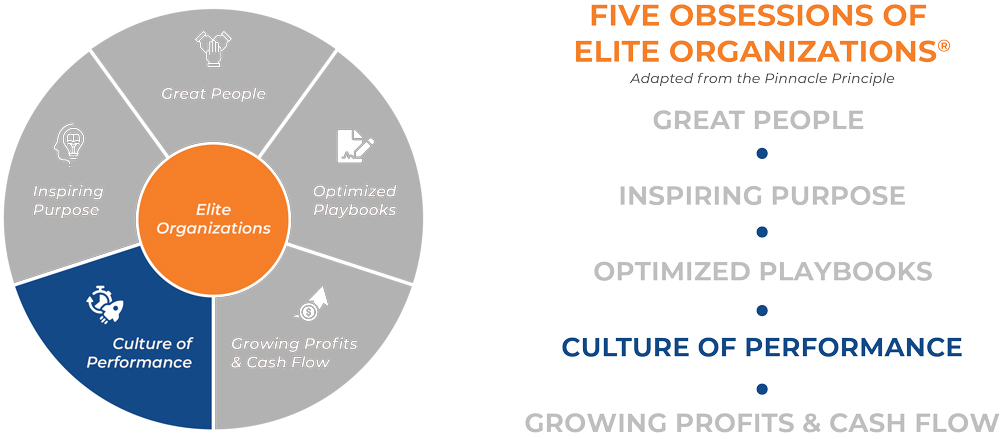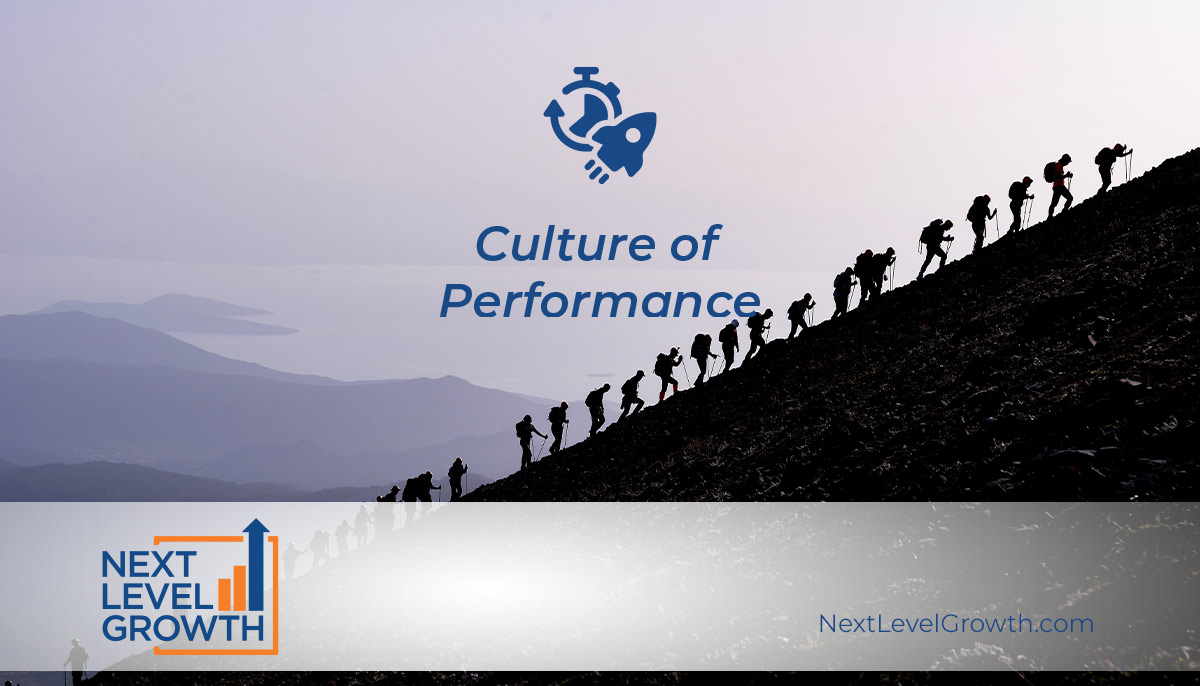Legendary college basketball coach, John Wooden, famously said we should, “Never mistake activity for achievement.” While it takes the right activities, done the right way, and the right number of times to achieve success, in my years as an entrepreneur and now Business Guide, I have seen firsthand that far too many organizations give teams and leaders a pass for too long because they are doing the activities, even when they are not achieving the desired results.
Building a high-performing culture into an organization is hard work and takes time. It requires a special discipline, focus, and drive to do things at a high level, and to a high standard, all of the time. It is also highly dependent on getting the first three of the Five Obsessions right. You must have Great People, united around and driven by an Inspiring Purpose, well trained on, and consistently executing, Optimized Playbooks, to even have a chance at building a successful Culture of Performance, the fourth of the Five Obsessions of Elite Organizations®.

Keys to a Culture of Performance
There are six key components to building a Culture of Performance. The first is to define what we call The Summit. What is at the top of the mountain you are climbing? In Good to Great, Jim Collins calls this the BHAG – the Big, Hairy, Audacious Goal. Once you know the long-term goal, the objective, then you can begin to focus on the remaining keys of building a Culture of Performance: The right strategy to become a dominant force in your strategic niche; an A-Player Recruiting and Onboarding System; Clear Expectations; Scorecards and Scoreboards; and a Coaching System to either coach people up or coach them out.
In my earlier post on an Inspiring Purpose, I discussed the importance of defining and driving the right strategy to differentiate yourself and provide consistent value in the marketplace. With the addition of a Just Cause and Daily Purpose, people can get clear on why you are in the game that you are in, and they can decide if they want to be a part of it. Adding in a clearly defined Summit helps them understand where this journey will take the organization, and then they can decide if successfully reaching that Summit will be worth the effort it will take. Some will be up for the challenge and others will not. You want to build on the former, and let the latter go on to other organizations. They will not help you drive your organization to its Summit because they don’t have the emotional connection, the passion and drive, to remain disciplined and focused on the journey.
An A-Player Recruiting and Onboarding System
The best organizations, whether in business or in sports, have a well-designed and executed system to attract and filter talent. It starts with having a very clear understanding of who your avatar employees are for each role in the organization, and the Next Level Accountability Chart™ is a great place to start. Once you understand the avatar, it is easier to figure out where they are and how to go find and attract them.
Many organizations offer referral bonus programs to compensate existing employees to recommend people they know. The problem is that few of the systems we have seen are really well designed to get ideal outcomes. As Brad Smart wrote about in Topgrading, A-Players will hire A-Players, but B-Players will only hire other B-Players and C-Players. They will not hire A-Players. So why do we incentivize our underachievers to recommend their peers? There is a high likelihood that their peers are also underachievers…so we end up paying our underachievers a bonus for helping us find other underachievers, and the cycle repeats.
At Next Level Growth, we regularly recommend designing a program that offers more lucrative bonuses for existing employees to recommend and recruit from their networks, but we always suggest that any such program should be tied to performance in a way that existing employees must be verified A-Players (both in terms of culture and performance) to even participate, and their bonus compensation on recruited employees should both be paid out over time, and only be paid if they maintain their A-Player status AND the new employee also remains a consistently verified A-Player (both culturally and in terms of performance). This way, you get two A-Players for the bonus you pay. As I wrote about in the article on Optimized Playbooks, every system is perfectly designed to get what it gets. If you want a better outcome, you need a better system.
Clear Expectations
As I wrote in my earlier post on Great People, I believe that most of our frustrations with people are rooted in uncommunicated expectations. The Next Level Accountability Chart™, with MMOs™ is a great tool to help clarify performance expectations of people in their roles. Once those expectations are clear, and you use them in the recruiting, hiring, onboarding, and continuous development phases of your employee journey, you will have the foundation of a system that is designed to help you drive performance from a team of great people.
As Nick Saban states in the video below, mediocre people don’t like high achievers, and high achievers don’t like mediocre people. If you don’t have a Culture of Performance, you cannot have any team chemistry within the organization, and you must have clear expectations if you are going to have a culture of performance.
Scorecards and Scoreboards
Imagine watching two teams playing basketball, but nobody is keeping score, there is no clock measuring the time remaining, and there are no other data points or statistics. It would be like watching practice, and probably would not be very interesting. I would also expect that the level of effort being put forth by the players would be less than their absolute best.
Compare that, however, to the way teams perform when there is a scoreboard, we know the score, the time remaining, what the team foul situation is, and how many time-outs are left. Suddenly, when we’re keeping score, the effort and focus improves.
Scoreboards and Performance: A Personal Example
It is a psychological fact that people perform differently when they know how they’re performing against certain goals, or against other individuals or teams. A few months ago, I took up cycling as a form of exercise. Since I’m purely doing this for the exercise, I passed on getting an expensive road bike and settled for a hybrid city bike. I’ve got a 10-mile route I ride several days per week and there’s about 500 feet of elevation change, so for a novice looking for exercise, it’s a good route. When I started riding, it was taking me about 45 minutes to complete the circuit.
I use an app to track my time, distance, average speed, and a few other points of data. One particular day, as I was climbing a 1.5-mile hill on the route, another cyclist passed me. Granted, he had a nice road bike and all the fancy gear and cycling clothes, while I was in gym shorts, a t-shirt, and sneakers…but I got frustrated at the thought of being passed. So in response, I put forth more effort, changed gears to pick up a little more speed, and was actually able to stay on pace with him for the rest of the climb.
What I realized was no different than what I observe with the teams I coach. When challenged, the competitive spirit that lives within most of us, will drive us to level up our performance. I also realized that when I was only competing against myself and my own stats, I was allowing myself to settle into something less than my best effort. Being passed woke me up. Now I know that I can push harder and go faster. Now I ride against the last version of me. When I finish a ride, I put the stats on a whiteboard in my office and I track them week by week. Every time I ride, I try to beat the guy I was the last time I rode. As a result, just last weekend I broke the 40-minute mark, twice. The prior version of me, the one that took 45 minutes to complete the circuit, would have been 1.1 miles behind me when I finished. That’s an 11% improvement in my performance, and I’m just a hack cyclist doing this for exercise.
Scoreboards and Performance: An Example From the Field
When I was President and CEO of Erath Veneer, we had four production lines, each running on two shifts, slicing hardwood veneer for the furniture, door, and panel industries. So in all, we had eight different production teams.
As we gained clarity around our Profit per X, which in our case was Dollars of Gross Profit per Board Foot Produced, we realized that of the many areas we could make adjustments and implement strategies to improve the ratio that drove our economic engine, focusing on and consistently improving our throughput in terms of board feet would be one area of focus that would make us more efficient and more profitable.
Note: This story, and many like it, are detailed in my second book, The Path to the Pinnacle.
We started by analyzing historical data on throughput, and supplemented that by running tests and time studies. This analysis allowed us to determine, by specie produced (think, “product line”), how much throughput per hour each production team should average for an eight-hour shift depending on the mix of species they were producing during a particular shift.
To make sure we didn’t sacrifice quality for the sake of efficiency, we added limit switches to each veneer slicer that would turn on a light at the same part of every log being sliced, and that would cue the team to pull a sample, which they would then label with the machine number, shift, time, and log number. The following morning, our production manager and sales manager (requiring the two positions to collaborate in the review prevented just operations from policing itself) would review the samples together and reject anything that did not meet our standards. For any mis-manufactured samples, the team that produced the damaged log would have the board footage of that log deducted from their prior day’s totals. So there was no incentive to sacrifice quality for volume.
After the samples were reviewed, our office staff would tally each of the eight production teams results from the prior day, and we would print a color bar graph that showed a thick black line where each team’s goal was for the prior day, along with a vertical bar indicating their actual results. If they fell short of their goal, the bar was red. If they met or exceeded their goal, the bar was green. We kept a rolling week of graphs up on the wall by the door to the break room, so every employee in the company saw the results. Nobody wanted to be on the teams that were consistently in the red.
Without any financial incentives, and just by displaying the data and letting everyone see how their team was doing relative to the other teams, we saw an 8% increase in average throughput per shift. That improvement in productivity, with a balanced focus on quality, lowered our unit cost, which increase our Profit per X – our Dollars of Gross Profit per Board Foot Produced.
Once we had consistent data to prove that we were doing the right things on our production lines and tracking the data properly, we reinvested some of the financial gains into a bonus program for the production teams that created a true meritocracy on the plant floor, increasing total compensating for the best performing teams. As a result of the clarity, visibility, and focus on results, team members would go out of their way to help each other as needed to keep their productivity up, and team leads would be quick to communicate with their supervisors when an underperformer was holding them back and needed to be exited from the team.
As an organization, it is critical to make sure that you are tracking, and providing sufficient visibility to, the right data to drive the performance you want, and using that data to create a healthy spirit of competition…something for which A-Players hunger.
A Coaching System
Every great performer has a coach. Many of them have multiple coaches. In his prime, Tiger Woods had four coaches – one for his long game, one for his short game, a strength coach, and a sports psychologist “performance” coach. What is your organization doing to develop your leaders into great coaches?
At Next Level Growth, we recommend that everyone who has direct reports be developed by the organization to coach their teams. As part of that coaching system, we recommend Quarterly Coaching, or what some of our clients call, Quarterly Calibrations. These are one-to-one meetings, once per quarter, between a leader and each direct report, where they discuss core values one at a time, and then performance relative to the defined Mission, Most Critical Outcome®, and Obsessions™ from the Next Level Accountability Chart™, again, each one at a time.
We encourage our clients to clarify and utilize a numeric rating system, with definitions for each of the numbers relative to expectations for both behavior in alignment with each core value, and then performance relative to each part of the MMOs. Is the team member exceeding expectations, meeting expectations, or not meeting expectations. We have some clients who choose to use a one to three scoring system, some that use a one to five system, and others that use a one to ten system. All that really matters is that the system is clear, it is consistently deployed throughout the organization, and the meaning of the numbers is defined.
When this is consistently done every quarter throughout the organization, you are validating with your high achievers how well they are doing, and you are identifying your under-performers so that you can work with them to understand their needs and help develop and coach them up. If, however, over time, you find that somebody is not responding to, or accepting, the coaching, then you can either coach them into another seat, or coach them out of the organization. This makes room for a new recruit to come through your onboarding processes and refill the seat with an expectation that the new, well onboarded recruit, will be able to perform at a higher level.
Never Settle
In the end, a Culture of Performance is a commitment across the organization, starting with leadership, to the same high standards and to the same high level of achieving results. You must commit to providing your team with the right strategy to become a dominant force in your space, an A-Player Recruiting and Onboarding System, Clear Expectations, Scorecards and Scoreboards, and a Coaching System to either coach people up or coach them out.
You cannot be great if you’re content with good.
Click to reac the next article in this series, Growing Profits & Cash Flow.
Learn how to approach Scorecards and Scoreboards with this free download
Next Steps
- If you have missed any of the articles in the series, click below to catch up:
- Start a conversation with us today to learn about our unique approach to taking your business, and your life, to the Next Level.






